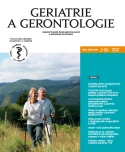The treatment of the water and electrolyte disturbances in geriatric patients.
Authors:
prof. MUDr. Zdeněk Zadák, CSc. 1; RNDr. Mgr. Alena Tichá, Ph.D. 2; MUDr. Radomír Hyšpler, Ph.D. 2
Authors‘ workplace:
Centrum pro výzkum a vývoj FN Hradec Králové
1; Ústav klinické biochemie a diagnostiky FN Hradec Králové
2
Published in:
Geriatrie a Gerontologie 2019, 8, č. 2: 64-69
Category:
Review Article
Overview
The water and electrolyte disorders are a frequently occurring and serious condition occurring in the old age. The causes of the water and electrolyte disorders are based on decreased capability of elderly individuals to adapt themselves to the pathological changes in the course of disease as well as to the effects of the outer environment. Approaches to this type of disturbances have markedly changed in recent years, in particular from electrolyte and water management towards the aspects of the intermediary metabolism in the course of disease. From this standpoint, adjustments of water and mineral management are dependent very much on nutritional support and energy balance of the patient. Some of the principal electrolytes, e.g. potassium and phosphorus, are of special importance in the view of the diseases of elderly individuals. These disorders participate in the development of clinical situation summarized under the term “a fragile patient.”
A new modern approach and differences in the treatment of water and electrolyte management are of special importance in intensive care and resolution of urgent conditions. The paper aims to emphasize some differences in the new views on the treatment of disorders of water and electrolyte balance with special regard to the specifics of the geriatric patients.
Keywords:
geriatric patient – water – electrolytes – energy balance
Sources
1. Zadák Z. Výživa v intenzivní péči. 2. rozšíř. aktual. vydání. Praha: Grada 2008.
2. Zadák Z, Tichá A, Hyšpler R. Poruchy vodní a iontové rovnováhy ve stáří. Vnitřnílékařství 2018; 64(11): 1059–1066.
3. Kaška M, Zadák Z, Živný P, et al. Vliv vysokého věku na vnitřní prostředí operovaných. In: Stárnutí populace – důsledky pro současnou medicínu. Česká gerontologická a geriatrická společnost ČLS JEP: Praha 2003.
4. Kazda A. Vnitřní prostředí I – voda, ionty, osmolalita. In: Kazda A. Kritické stavy. Metabolická a laboratorní problematika. Praha: Galén 2012.
5. Zadák Z. Léčba hyperkalcemie. Medicína po promoci 2005; 6(1): 42–44.
6. Zadák Z,Tichá A, Hyšpler R. Suplementace hořčíku – farmakologické mechanismy, metody podání a pasti. Klinická farmakolologie a farmacie 2017; 31(3): 16–18.
7. Hyspler R, Ticha A, Svobodová I, et al. Evaluation of magnesium deficiency in the Czech population and the influence of supplementation by magnesium-rich mineral water. Clinical Nutrition Suppl 2012; 7, Supl 1: 255–256.
8. Zadák Z, Havel E. Intenzivní medicína na principech vnitřního lékařství. 2. dopl. a přeprac.vydání. Praha: Grada 2018.
9. Lobo DN, Lewington AJP, Allison SP. Basic Concepts of Fluid and Electrolyte Therapy. Melsungen: Bibliomed-Medizinische Verlagsgesellschaft 2013.
Labels
Geriatrics General practitioner for adults Orthopaedic prostheticsArticle was published in
Geriatrics and Gerontology

2019 Issue 2
Most read in this issue
- Risk and complications of the robotic partial nephrectomy in patients in age over 65 years
- The treatment of the water and electrolyte disturbances in geriatric patients.
- TRUS/MRI fusion prostate biopsy in patient over 65 years – results and complication rate analysis.
- Are robot-assisted radical prostatectomies safe in patients over 65?
